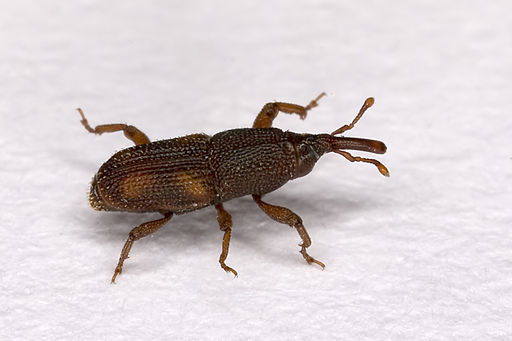SERVICE REQUEST?
Fill out the form below.
Find our nearest location
Your Local Office

Rice & Granary Weevils
Attribution: Olaf Leillinger, [CC-BY-SA-2.5 or GFDL], via Wikimedia Commons
Size:
1/8 inch in length
Color:
The rice weevil is dark brown and usually has four light-colored patches on its wing covers. The granary weevil is uniformly dark brown in color.
Behavior:
Both the rice and the granary weevil are internal feeders and the larva develops inside whole grain kernels. The female weevil bores a small hole into a grain kernel and deposits a single egg into the hole. She seals this hole with a gelatinous material and then repeats the process on kernel after kernel until she deposits 300-400 eggs. As a general rule, however, about 50% of the eggs do not hatch. The “C” shaped, creamy white, legless larva emerges from the egg and completes its life feeding within the kernel. The kernel will eventually be hollowed out and the larva pupates within. After pupation, the adult beetle remains inside the kernel for a while before chewing its way out. The open, round exit holes are sign of a weevil infestation. Weevil exit holes differ from the exit holes created by the grain moth because they are open. The moth leaves a little, hinged “lid” over the hole. Within infested grain, the size of the weevils seen can vary greatly. A weevil’s size is dependant on the size of the grain kernel in which the larva developed. Rice weevils are prolific breeders and can build up huge populations in stored grain to the point where the grain has little value as a food product. Infestations located in storage bins, silos and grain elevators have been found to a depth of about 5 feet. The grain deeper than that is usually too warm to support the weevils’ survival. When disturbed, both types of weevil “play dead” by drawing their legs close to the body. They then lie still for several minutes before resuming movement. The granary weevil does not fly while the rice weevil is an active flier. It often flies to grain storage bins and buildings from nearby fields and from one end of a warehouse to the other.
Both rice and granary weevils mainly attack whole grains, such as wheat, corn, barley and rice. These weevils may also be found infesting in such foods as macaroni and spaghetti when they get old. Rice weevils also feed on beans, nuts and cereals and have been observed sucking the juice from apples and pears. In homes, infestations are generally found in bird seed, nuts, decorative Indian corn and, in rare instances, in old pasta stored in cupboards. The adults feed on the same foods as the larvae but are not as restricted in their diets because the larvae need to develop inside whole grains. The rice and granary weevils are the most economically significant pests of stored whole grains in the world. The granary weevil is more common in northern states while the rice weevil is more prevalent in the southern states. Both beetles, however, may be found throughout the world. In southern states, adult rice weevils will overwinter in the fields.
The control of any stored product pest involves many steps, primary of which is discovery of infested food items or other sources of infestation (e.g., food spillage accumulation). All products containing or made of whole grains need to be inspected. Decorative items, such as Indian corn and shadow boxes containing seeds also need to be checked. Rice and granary weevils have also been found infesting old pasta products and bird seed. On rare occasions, infestations have also been traced to caches of nuts and seeds accumulated by squirrels or rodents within attics, walls and chimneys. A pest management professional can be helpful in finding difficult infestation sources. Consider the following to prevent an infestation: · Discard infested foods in outdoor trash. Infested decorations (flowers, wreaths, etc.) should also be discarded. · Freeze suspect foods at zero degrees Fahrenheit for six days. · Clean cabinets and shelves where infested foods are stored by vacuuming and by using soap and water. · Store all dried food goods, including dried pet foods and birdseed, in a glass or plastic container with a tight lid. If beetles are in that food product then the infestation will be contained and not spread to other foods. · Consider storing cereals and similar foods in the refrigerator to limit stored product pest problems. · Consume older food products prior to newer purchases of the same food. Products purchased in larger quantities (e.g., from a wholesale food warehouse) are more likely to become an infestation source if these are stored for long periods of time – especially if they are not stored in containers with tight-fitting lids.
Family Name:
Sitophilus oryzae, Sitophilus granarius
Read What Our Clients
Are Saying
My Terminix tech Scott is the best! He is professional, courteous and absolutely thorough about his job. Thank you for sending such a blessed tech to my house. Hamlet, NC
This letter is to say how pleased we are here at Morreene West Apartments with your services. We are very pleased with the technician, Christopher. He does a great job. Durham, NC
Terminix has consistently offered our apartment complex reliable, competent service. We are completely satisfied with their knowledgeable representative who is always punctual and does a superior job for us every time. Chapel Hill, NC
I would like to take the time to thank you for giving us such great service here at Carver Pond Apartments. Your Pest Technician Christopher Mitchell has provided us with excellent service over the last few months. Christopher is such a great help to us in providing helpful information so that we can better serve our residents here at Carver Pond. Durham, NC
SERVICE REQUEST?
Fill out the form below.